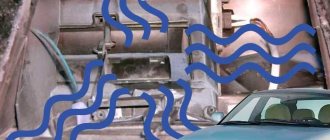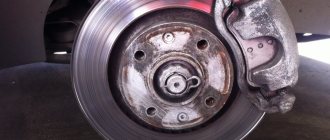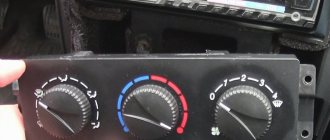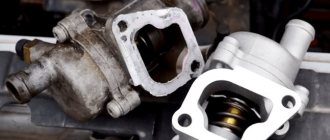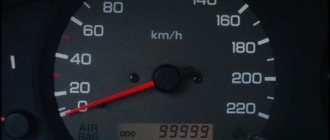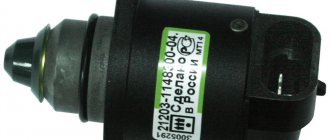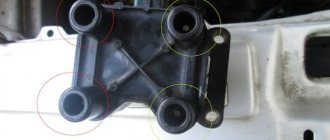Situations in which drivers wonder why the heater blows cold air at idle are not uncommon. Most often, they include novice motorists, women and owners of “middle-aged” cars, but exceptions are possible. What should you do if this happens to you? – Of course, look for the cause of the problem and eliminate it. This is what we will do now.
The principle of operation of the stove in the car
The vehicle heating system includes:
- heater radiator;
- pipes;
- Control block;
- coolant pump (pump);
- heater tap.
The process of heating the car interior goes like this:
- Coolant circulates in the system due to the operation of the pump.
- During the heating process of the engine, heat is removed from it.
- Hot coolant enters the radiator, heating it.
- The stove fan takes air from the engine compartment and then supplies it to the cabin through the heater radiator, which heats it up.
- This cools the fluid as a result of heat exchange (the engine receives cool antifreeze, and the interior receives a flow of warm air).
This is how the heating system in most cars works. Accordingly, the temperature of the air that enters the car interior depends on the performance of various system components.
The main reasons why the stove does not heat well at idle:
- malfunction of the water pump (pump);
- air lock in the system;
- lack of coolant;
- burnout of the cylinder head gasket;
- malfunction of the stove tap;
- clogged pipes and heater radiator;
- thermostat malfunction;
- internal damage to the heater radiator.
Now let's look at how to determine the presence of each of these problems.
The stove is blowing cold air due to problems with the cooling system
A fairly common reason why the stove may blow cold air is neglect of maintenance requirements for the cooling system or its failure. To fix this problem, we need to perform a few fairly simple steps:
- First, we replenish the supply of coolant, adding it to a certain level;
- if this does not help, start the engine and monitor the temperature sensor as it heats up. If it remains at the same level, the thermostat valve may be broken, which should be urgently replaced with a new one;
- the last stage is to check the presence of air in the cooling system, which penetrates into it through the broken cylinder head gasket. This malfunction is usually indicated by such symptoms as a leak of antifreeze, which can splash out of the tank and mix with oil, too high a temperature on a sensor located inside the passenger compartment, and “triple” of the engine.
The last fault can be eliminated by installing a new gasket. It firmly blocks the access of air, and the problem disappears on its own.
Pump malfunction
Very often, drivers explain poor performance of the heater at idle by a breakdown of the water pump. This is due to the fact that at XX the pump impeller rotates at low speed, which cannot ensure high-quality circulation of antifreeze (antifreeze). As a result, heat exchange deteriorates and insufficiently hot air enters the cabin. When you press the gas pedal, the speed of rotation of the impeller increases, which immediately entails an increase in the air temperature in the cabin.
We published an article on how to check the pump without removing it from the engine -
For more accurate diagnostics of the pump, it must be removed from the engine. Very often, a pump malfunction is accompanied by overheating of the motor. A visual inspection of the item will indicate its condition. If the impeller is jammed, spins on the shaft, or its blades are scattered, the pump must be replaced.
Replacing the cable
Quite often, car owners manage to improve the operation of the heater by replacing the cable that is responsible for controlling the heater damper. After replacing or tightening the stretched cable, the stove in the VAZ-2109 begins to function normally, and warm air begins to blow both into the interior and onto the car windows, which is especially important in inclement weather. It is recommended to replace or tighten the cable in the following sequence:
- if a visual inspection indicates that the cable cannot be used in the future due to obvious damage, it must be replaced as quickly as possible;
- if this element is simply stretched, then you can tighten it with a regular screwdriver by making a couple of turns clockwise;
- Finding the cable is quite simple; it is located on the heater body, near the gas pedal.
A correctly adjusted length of the cable, which you can learn from the training video tutorial on the Internet resource, will help keep the damper in the desired position, which, in turn, will close the resulting gap and the interior will begin to be heated by a warm air flow.
Air lock and lack of coolant in the system
This is an easily fixable problem. The culprit may be a faulty expansion tank cap that is unable to maintain the required pressure in the system. Another reason for the formation of traffic jams is a lack of coolant. Poor circulation leads to the stove blowing cold air at idle. When the car starts moving, the air temperature rises, and after stopping it drops again.
To eliminate the problem, you need to check the antifreeze level and, if necessary, add coolant. Also check the system for leaks and repair any leaks if found. Often pipes leak at the joints, but the radiator itself may be the culprit. If the reservoir cap does not work, replace it with a known good item.
After this, you need to get rid of the air in the system by installing the machine on a hill or overpass so that its front part is higher than the rear. Start the engine and open the expansion tank cap. Excess air should be released from the system. If after some time the plug appears again, this may be a sign of a cylinder head gasket failure.
Advice from experienced car owners
Eugene:
“I never thought I would encounter such a problem, but it happened. After repairing the cylinder head, it became very difficult to warm up the interior. I spent a long time searching for why, and it turned out that the engine was throttling. I did everything as advised, the coolant stopped bubbling only after 4 hours, but now it’s always warm in the cabin.”
Sanya:
“I have a VAZ 2109i, it blew cold at idle. I added coolant to the expansion tank, everything was ok.”
Rustam:
“I drive a 6th Mazda. Last winter, the heater began to act like a fool: over 2 tons of revolutions, hot air came out of it, over 3 tons, despite how much the temperature was set, the heater practically boiled with boiling water, but as soon as you stopped, the air became cool. I went through all the possible options described in the article, the problem did not go away, after a long search, the service station technicians found the reason - the climate control system had failed.”
We recommend: Installing fog lights on the VAZ-2107
Ruslan:
“On my Priora, the stove also blew cold at idle, so to fix this I had to constantly add antifreeze. Got tired of it, sealed the lower pipe, now everything works properly.”
Oleg:
“As a service station worker, I can say that the warmest stove among all domestic cars is in Kalina, but sometimes it also malfunctions. As a rule, the whole problem lies either in the gasket of the pump, or in the pump itself, so if you are the owner of the named car, in which case the first thing you should pay attention to is the pump and its components.”
Failure of the cylinder head gasket
You need to understand that damage to the cylinder head gasket leads to mixing of oil with antifreeze or exhaust gases entering the cooling system. Usually the problem is quickly diagnosed by obvious signs. But some drivers note that minimal burnout of the gasket may be accompanied by the appearance of excess air in the cooling system.
The only solution may be to replace the cylinder head gasket, but we advise you to take your time and check all other factors first. This is an expensive procedure and a rare problem, so save it for last.
Troubleshooting methods
Methods for eliminating the problem of why the stove blows cold air at idle will depend on the reasons themselves, which have been rechecked in order. So, first of all, you need to check the coolant level in the expansion tank. Please note that this must be done on a cold engine (!!!) so that the coolant is also relatively cold and the car owner does not get burned.
If it is below the middle, then add coolant. In this case, it is necessary to take into account the compatibility of antifreeze. It is advisable to fill it with the same brand and class that is in the cooling system. If the antifreeze has not been changed for a long time and/or is in poor condition, then it is better to replace it with a new one.
If air pockets form in the cooling system, they must be removed. There are three main methods for removing air from the cooling line. They all boil down to allowing the engine to run with the system depressurized so that the air can come out of the system on its own during the antifreeze circulation process. You can perform the procedure for removing air from the cooling system yourself in the garage or even in the field.
When the check shows that the pump is faulty, it will have to be replaced accordingly. But to identify the problem, you will have to dismantle the water pump. Often the cause of failure lies in wear of the impeller, bearing, or depressurization of seals. As for the bearing and rubber seals, in some cases they are replaced with new elements.
If the reason lies in the difficulty of the passage of liquid through the heater radiator, then you can try to rinse it. At the same time, it will be possible to see if it has cracked the body, and, accordingly, if antifreeze is flowing through it and if air is being sucked in. Typically, flushing has a positive effect on the efficiency of the heater, including at idle speed of the engine, as well as when the car is driving on the highway or in the city driving cycle at high speeds.
If the car heater has a valve for supplying liquid to the radiator, then do not forget to check its operation. So, for example, on VAZs (both new and old), this is one of the weak points of the interior heating system.
When the stove heats poorly only when starting on a cold engine and the engine itself does not reach operating temperature for a long time, then the first thing you should do is check the operation of the thermostat. So, for the first few minutes, until the coolant reaches an operating temperature of about +80°C...+90°C, the pipe leading to the top of the main radiator will be cold and relatively soft. The thermostat valve should only open when the antifreeze is warm enough. If yours is different, the thermostat must be replaced. In rare cases, you can try to repair it, but it is better to install a new one.
The car's climate control system operates on the basis of its own separate software and hardware. Therefore, checking its operation depends on the specific brand of car and the type of system itself. The verification algorithm is usually described in the car manual. If such information is available, you can check it yourself. Otherwise, it is better to seek help from a car service center, preferably one that specializes in working with the specific brand of car being tested.
Conclusion
If the stove heats only when moving, first of all you need to check the level of antifreeze in the cooling system, as well as its condition. Next, you need to check the pump, thermostat, radiator, heater valve, and the presence of air pockets in the system.
If, when the engine warms up at idle, the heater blows cold for too long, then it makes sense to insulate the radiator grille with improvised or special means. In any case, remember that a poorly functioning stove in any case indicates problems in the engine cooling system, and operating a car with similar problems is fraught with costly repairs in the future, so repair work must be carried out as quickly as possible.
FAQ:
- Kalina's stove doesn't heat well at idle
- Skoda Octavia heater does not blow at idle
- Audi A6 heater blows cold at idle
Stove valve malfunction
All cars use a valve that shuts off the flow of coolant through the heater radiator. It is he who is controlled by the “heat - cold” switch on the center console in the cabin. For various reasons, the tap may not open completely. In this case, the stove does not heat up at idle speed, since not enough hot antifreeze enters the radiator.
The solution is simple - the faucet must be replaced. We advise you to choose high-quality spare parts, since cheap taps quickly fail and jam in the closed or open position.
Clogged radiator
Over time, scale forms in the radiator, which creates plugs. The obstruction of the lines leads to a decrease in the pressure that supplies warm air. At high speeds there may be an increase, but at idle you won’t get any warmth. What to do? Theoretically, you can try flushing the radiator yourself. Many auto stores offer special mixtures that destroy salt compounds. But purging and flushing will only work if the lines are not completely clogged. If there is no circulation in one of the pipes, then it will not be possible to flush it. Replacement only. Advice may also include checking the thermostat, replacing the filter (if available), and the gasket. But in practice, the stove does not heat up at idle in 90% of cases precisely because of the high wear of the radiator . To avoid such problems, it is recommended to take preventive measures in time. Use a high-quality cooling mixture, change it regularly, monitor the quality (after draining, for any impurities), do not mix several models of antifreeze. Operate your car competently and enjoy a warm car in winter.
Clogged pipes and heater radiator
During the operation of the car, dirt accumulates in the pipes and the radiator itself. This may occur due to the use of low-quality coolant or its untimely replacement. As a result, circulation in the system deteriorates, which is why there will be no heat at idle.
The way out of the situation is to flush the entire cooling system. It is necessary to drain the antifreeze, add distilled water, adding a small amount of citric acid. There are also special cleaning products. We recommend washing in several stages. In very difficult cases, it is better to replace the stove radiator.
Damper repair or replacement
It happens that the damper is “stuck” - that is, it stops turning due to the fact that the fastenings have oxidized and have not been looked at for a long time.
In the VAZ 2110, you can only “get close” to the damper from under the hood. First you need to remove the deflectors, then bend the antennae. Now try to move the flap by hand.
https://youtube.com/watch?v=2Ci9giL3p88
If it works and “walks” easily, then the reason is something else. But in any case, knowledgeable car enthusiasts recommend replacing the plastic damper with an aluminum one.
This small modification allows for better heat retention, the stove will work better, since, plus, there will be no deformation, which plastic dampers are prone to.
Thermostat malfunction
Sometimes the thermostat can become stuck open. As a result, antifreeze will constantly circulate in a large circle. Accordingly, it will not be able to warm up normally. In some cases, the thermostat simply does not completely close the large circle. This has virtually no effect on engine operation, so diagnosing the problem is difficult.
The solution is to check the thermostat and replace it if a malfunction is detected.
Antifreeze supply is blocked
Almost all car models are equipped with taps that allow you to shut off the supply of antifreeze to the heater. This allows you to avoid problems with overheating of the interior during the warm season. But at the same time, the faucet is the weak point of the interior heating system. Check the position of the tap. Maybe it just needs to be opened. But this is not always easy on domestic cars, and on many foreign cars the valve can jam. Then it will have to be replaced. This is done quite simply. If you have any of the VAZ models, then it is better to spend a little more money and buy a part from Audi. In this case, you will not have to replace it every six months.
Internal damage to the heater radiator
In addition to a clogged radiator, some VAZ car owners have discovered another factor why the heater blows cold air at idle. In the heater radiator there is a partition between the coolant supply and outlet pipes. It may crack or crumble, preventing proper fluid circulation inside the radiator.
The problem can only be detected after disassembling the radiator, so it is better to have a working part on hand to check. If installing a working radiator solved the problem, you can simply throw away the old one. It is unlikely to be repaired.
Finally, I would like to advise you to monitor the proper operation of the engine cooling system of your car, use only high-quality coolant (read our article about whether it is possible to mix antifreeze of different colors -) and adhere to the manufacturer’s recommendations!
Why doesn't the stove heat well?
There are several known reasons indicating that the stove heats well only at high speeds:
- There is air in the heating system. The stove does not function normally when air gets in when replacing antifreeze. It can also get into the heating system if the integrity of the cylinder head is damaged.
- The heater radiator is clogged. There are several reasons why the heater radiator is clogged inside and outside. From the outside, it gets clogged through the protective casing, as a result of which dust, leaves, insects, etc. get into the stove radiator. The inside of the radiator becomes clogged exclusively during operation with various dirt and deposits that are present in the engine cooling system, as well as due to the use of low-quality antifreeze.
- Thermostat is faulty. The thermostat in your car may become stuck open and closed. Moreover, if the stove heats well only at high speeds, but poorly at low speeds, most likely the reason is that it is jammed in the open position.
- Fan failure. The function of a fan in a car is to pump air into the cabin; if it works poorly due to failure of the bearings or graphite brushes, unstable operation of the heating in the cabin and the entire ventilation system will occur. Also, the cause of fan failure may be a problem in the electrical power circuit.
- Heater valve malfunctions. As a rule, such malfunctions occur only in car heaters of domestic brands: the rubber bands may dry out, the valve lever may wear out during operation or become sour.
- The cabin filter is clogged. Severe contamination of the filter is the reason why the car only heats up while driving. It should be replaced once a year.
- Damage to the stove control unit. This malfunction also causes trouble for owners of domestically produced cars. Malfunctions in the operation of the control unit can be caused by a breakdown of the air temperature sensor.
These are not all the reasons that affect the operation of the car’s heating system, but these are the ones that most often arise among motorists.
